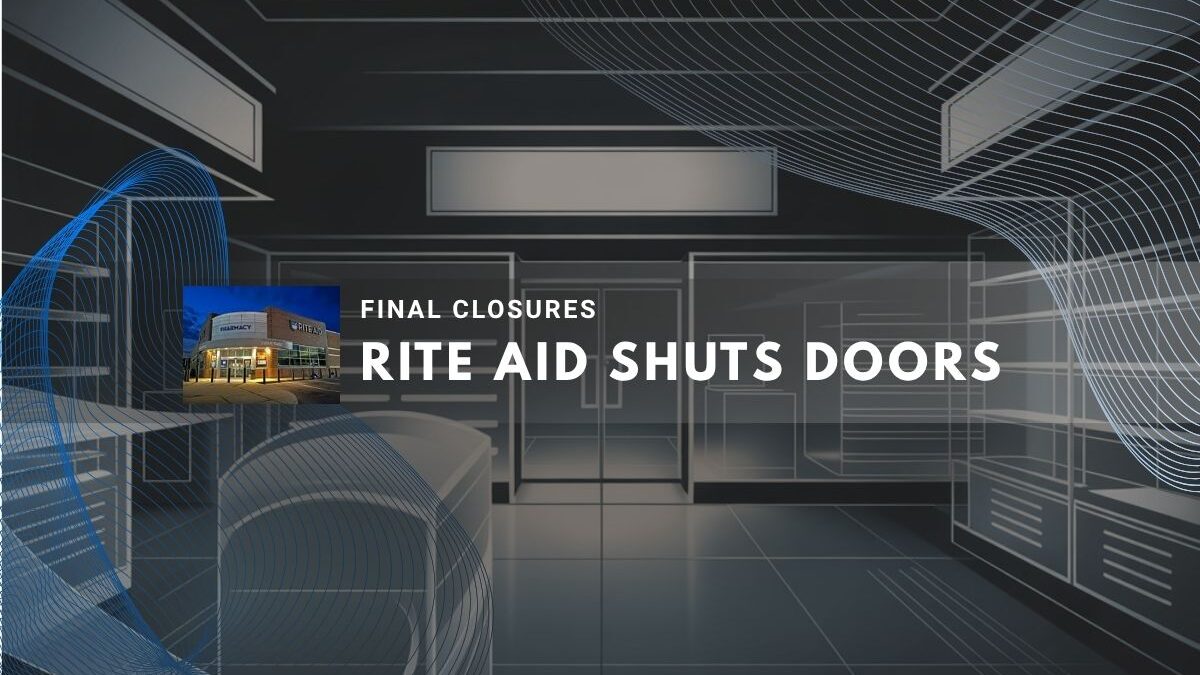Rite Aid has closed all its remaining stores after filing for bankruptcy twice in less than two years, ending over six decades of operations. The company announced the shutdown on its website on October 3, 2025, marking the final collapse of what was once America’s third-largest pharmacy chain.[1][2]
Timeline of Store Closures
Rite Aid shuttered its last 89 stores this week, completing a rapid decline that began with its first bankruptcy filing in October 2023.[3] At that time, the company operated over 2,100 locations across the United States.[4]
The first restructuring reduced debt by approximately $2 billion and led to the closure of roughly 800 underperforming stores.[5] Rite Aid emerged from bankruptcy in August 2024 as a private company, but still carried $2.5 billion in debt.[6]
Second Bankruptcy Filing
In May 2025, Rite Aid filed for Chapter 11 protection again, operating approximately 1,277 stores across 15 states from California to Vermont.[7] The company secured $1.94 billion in new financing from existing lenders to maintain operations during bankruptcy proceedings.[8]
CEO Matt Schroeder emphasized the focus on ensuring uninterrupted pharmacy services for customers and preserving jobs for associates.[9] However, the company ultimately pursued a court-supervised sale of remaining assets, with most pharmacy operations sold to CVS, Walgreens, Albertsons, Kroger and Giant Eagle.[10]
Company History and Peak Operations
Founded in 1962 as Thrift D Discount Center in Scranton, Pennsylvania, Rite Aid grew into one of America’s largest pharmacy chains.[11] By 1987, it had become the largest drugstore chain in the United States with more than 2,000 stores.[12]
At its peak, Rite Aid operated approximately 5,000 locations nationwide.[13] The company had opportunities to merge with Walgreens in 2017 and Albertsons in 2018, but rejected both offers.[14]
Failed Turnaround Efforts
CEO Heyward Donigan, appointed in August 2019, launched the RxEvolution strategy, which included a new logo, revamped stores branded as Stores of the Future, and a shift toward holistic health services.[15] In late 2020, Rite Aid acquired Seattle-based Bartell Drugs, adding 67 stores for $95 million.[16]
Despite these efforts, Rite Aid posted significant losses, including $750 million in fiscal year 2023.[17] Donigan resigned in January 2023, replaced by interim CEO Elizabeth Burr.[18]
Opioid Crisis Legal Challenges
Rite Aid faced more than 1,600 lawsuits related to its role in the opioid crisis by late 2023.[19] The Justice Department filed a complaint in March 2023, accusing the company of violating the False Claims Act and Controlled Substances Act by filling unlawful prescriptions for oxycodone, fentanyl and benzodiazepine.[20]
The company denied the allegations but reached a settlement with the Justice Department in June 2024.[21] Under the agreement, Rite Aid paid the government $7.5 million without admitting wrongdoing.[22] The settlement resolved allegations that Rite Aid pharmacies ignored internal red flags about suspicious prescriptions.
In 2022, Rite Aid had paid approximately $30 million to resolve separate lawsuits claiming it contributed to opioid distribution across the United States.[23]
Industry-Wide Pharmacy Closures
Rite Aid’s closure reflects broader challenges facing the pharmacy industry. Other major chains have closed thousands of locations in recent years due to heightened competition, inflationary pressures, and increased theft.[24]
CVS Store Closures
CVS launched an out-of-court restructuring in 2021 to close 900 of its nearly 9,900 stores.[25] The company shut down 300 locations annually in 2022, 2023 and 2024, then expanded closures in 2025 by announcing 271 additional store shutdowns in its February annual report.[26] Since 2021, CVS has closed over 1,171 stores total.[27]
Walgreens Restructuring
Walgreens, recently acquired by private equity firm Sycamore Partners, evaluated 2,000 of its approximately 8,600 stores for potential closure.[28] The company identified 1,200 locations to close over three years, with 500 shuttered in fiscal year 2025.[29]
Pharmacy Desert Concerns
Experts have raised concerns about pharmacy deserts, where communities lack convenient access to prescription services.[30] Between 2023 and 2025, Rite Aid alone closed approximately 2,088 stores.[31] The combined closures from major chains have left many Americans living far from pharmacies, particularly affecting rural and underserved urban areas.
Rite Aid’s website now provides tools for former customers to retrieve pharmacy records and find new pharmacies where prescriptions were transferred.[32]
